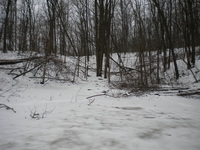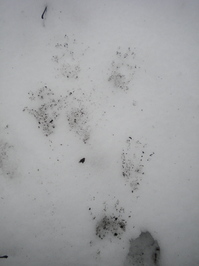Pondcast: Week 3 - Punky ice, snow fleas, raccoon, crows, and water sampling

Black Pond: January 18, 2010
Stefan Szumko | Contributor
Week 3 Pondcast
It’s been an exciting week at Black Pond. The above freezing temperatures last weekend caused the snow and ice to melt, giving it a “punky” texture. “Punky ice” is, apparently, a regional term describing “rotten ice” or “soft ice” which is slightly slushy and medium-grey in some areas. Punky ice is not to be trusted on lakes or rivers without personal safety gear.
Ice on lakes, rivers, or ponds is safe to walk on if the water body is completely frozen over and the ice depth is at least 10-15 centimeters (4-6 inches). Frozen lakes are not silent as the ice expands and contracts due to temperature changes. This is quite disconcerting while walking across a lake at night. Does the ice on Black Pond groan at night in the winter? Punky ice on lakes may be safe at a depth of 20 centimeters (8 inches).
Weather observations for the week noted at Rudolf Steiner High School, 300 meters from Black Pond.
Alex and I did chip a hole in the ice to collect a water sample in hopes of finding aquatic organisms living under the ice. Results of our investigation will be revealed next week. I did test the ice first to make sure it was safe enough for Alex to assist, once I determined that the ice was about 15 centimeters (6 inches) deep. He got to break through to the liquid water beneath with a final ice depth of 18 centimeters (7 inches). Rounded up, we’ve got the required 20 centimeters for safe walking. Plus we stayed close to the floating boardwalk and I went first.
We then used a ski pole to determine how deep the pond really is: about 1 meter (39 inches). Very exciting. Since my first visit to Black Pond in 1994, I had never stuck a stick in the pond to see how deep it was. I had not wanted to disturb the habitat with repeated measurements. Once the snow and ice melts in the spring, the water looks only to be about 30 cm (1 foot) deep. In the fall, the top layer of mud and leaves does dry up and looks solid. But thinking about it, the actual depth makes sense. 14,000 years of accumulated layers of leaves will hide quite a bit of water.
As we become more sophisticated in our exploratory endeavors, we hope to begin to take measurements of temperature, pH, and other chemicals in the water.
Although we did not see evidence of our mouse friend, whose tracks were in the snow the first two weeks of January, it now has a name, Pond-Rover. Thanks to Krista S. who provided the suggestion. We can only speculate why we were unable to observe evidence of this rodential visitor. It may have:
- Decided to stay hidden in its nest (location unknown), feasting on stored food.
- Moved away from the pond up onto the hill of the glacial moraine. Since its tracks led off the trail, I have decided not to follow them. This could encourage other humans to follow my tracks and create a new trail, which would degrade the natural habitat of the pond.
- Been active, but was unable to leave prints in the snow that turned into larger ice crystals due to last weekend’s thaw.
- Died in an unseen location.
- Been eaten by a predator, but there is no evidence near the pond to suggest this.

Muddy raccoon prints at Black Pond.
Stefan Szumko | Contributor
One possible predator of our mouse, Pond-Rover, is the raccoon that visited Black Pond. Raccoons are known to eat rodents among other things. The raccoon did seem to follow the trail left by Pond-Rover up the hill. Why was the raccoon at the pond? Since it left muddy prints, it most likely dug into the leaf litter under the floating boardwalk and may have dug in the hillside surrounding the pond, far enough away from the trail to be unseen. The extensive off-leash dog footprints did provide confusion, since there was evidence of digging, perhaps by these canines. Additionally, raccoons prefer to wash their food whenever possible. Perhaps it used the thawed water at the pond for that purpose?
On top of the snow throughout the woods and along the trails were snow fleas , a type of springtail. These insects eat decaying organic matter and produce a protein, containing glycine, which acts as an anti-freeze to survive at sub-freezing temperatures.
In the trees above the pond, a pair of crows was seen and heard “caw-ing” out to each other. You might see large groups of crows throughout town each winter. Most of these crows spend the rest of the year farther north of Michigan. Perhaps they find our winter weather balmy? Many of our crows head further south. In winter, crows will spend the day searching for food. They gather together in woodlots throughout town in larger groups about an hour before sunset. At sunset, these groups will travel to an overnight roost, possibly finding safety in numbers. The two overnight roosts in Ann Arbor are around Forest Hill Cemetery and the Material Recovery Facility (the old landfill). In 2008, over 30,000 crows were observed in Ann Arbor during the winter bird survey conducted by the Washtenaw Audubon Society. Please don’t be alarmed if see these big birds flocking together, they’re just being crows.
Join us next week when we observe the effects of the January rainstorm on the pond and blow up the organisms we found living under the ice.
Photo Captions:
1. Black Pond: January 18, 2010 2. Muddy raccoon prints at Black Pond
Stefan Szumko is a middle school science teacher by trade, an outdoor environmental educator by calling, and a homedaddy by choice. He can be reached at slugwhisperer@gmail.com.


Comments
tmacek
Mon, Jan 25, 2010 : 6:18 p.m.
what a nice story of nature in Ann Arbor. A beautiful town with so many natural resources that we so often overlook! Even snow fleas!